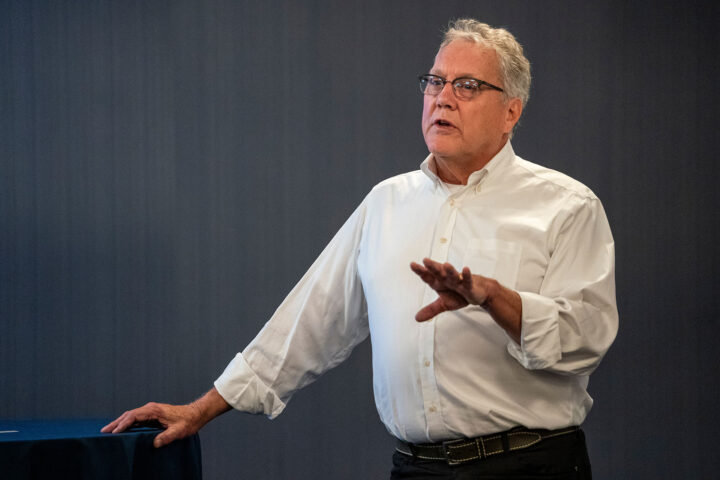10/17/2023
The why, how, and when of capital campaigns explained at Stewardship Kaleidoscope
by Robyn Davis Sekula

Why should a church have a capital campaign? And how do you ask members of your congregation – who are already generous – to contribute?
Rev. Dr. Tim Hart-Andersen, who is soon retiring as lead pastor of Westminster Presbyterian Church in Minneapolis, worked his way through much more than the nuts and bolts of capital campaigns during his presentation at Stewardship Kaleidoscope, an annual conference held this year in Minneapolis. The Presbyterian Foundation sponsors the conference.
Hart-Andersen’s presentation centered around six key principles to keep in mind when conducting a capital campaign at a church.
- Financial stewardship is about relationships. “You really shouldn’t be getting into a capital campaign unless you feel your relationships are good,” Hart-Andersen says. This means between the pastor and the church. Evaluate if the church is in a good place to start a capital campaign before moving ahead, and realize that the pastor will have to take the lead role in raising funds for the campaign.
- This leads to the next principle Hart-Andersen outlined: people give when they trust us, and the church. People want to know how their money will be used. Your congregation seeks transparency and accountability around money, but also around actions that the church takes. If you promise that you’ll take a particular action, you need to make sure you do it. Keep communication coming as the project moves along to build trust.
- There is always more money than we imagine available within the congregation. A surprising number of people may have capacity to give more than they do. Most people aren’t comfortable discussing money so this can be hidden.
- Don’t protect people from their own generosity. In other words, don’t give an apologetic pitch for a gift. Don’t tell them you know it’s not a good time, or that you’re sorry you have to ask. Let them determine what they can give, make the ask, and allow them to respond. “Help people access their generosity,” Hart-Andersen says. “These people are Christians and they trust in a loving God, who has been generous to them in their lives.”
- People want and need to be asked to contribute. And those asks should occur in person, preferably in the home of the donor, where they are comfortable. “Members of your congregation are being asked by cultural institutions and their alma mater – why isn’t the church in that mix?” Hart-Andersen asks. “And don’t just assume they will make a gift. They need to be asked.”
- You can’t ask if you haven’t given yourself. “Your gift doesn’t need to be the biggest gift,” Hart-Andersen says. “Most of us can’t do that. But you should tell them that you’ve made a commitment.”
When and why to have a campaign
Capital campaigns can be conducted as often as every six years if needed; in fact, Hart-Andersen notes that many congregations have needs that are unmet right now because they can’t pay for these things out of their budget.
Building and property needs are usually the reason a church has a capital campaign. Debt retirement is another reason. “Debt is not the trustees or finance committee’s problem,” Hart-Andersen says. “It’s the church’s problem.” There are some who will not contribute to the campaign because they don’t feel the church should have ever gotten in debt in the first place; others will understand the weight of debt and want to help the church become debt free.
During Westminster’s most recent capital campaign, one church member decided instead of giving an estate gift, they would give cash to the church now to help retire the debt. The member saw the value in helping immediately – while they were still alive to see the great results and feel the satisfaction of helping.
Another reason to have a capital campaign is an operational budget boost. If your church is seeing lots of growth in the neighborhood around you, and you want to prepare to serve those who are moving to the area, you could raise funds to hire additional staff members to meet those needs.
Mission component
Hart-Andersen emphasized the importance of capital campaigns having a mission component. He encouraged church leaders to consider a tithe – 10 percent – to go to mission in a capital campaign, or even a “double tithe” – 20 percent.
At Westminster, the church conferred with leaders of Presbyterian World Mission to ascertain where the needs were greatest and included that in their campaign. At that time, the needs were greatest in South Sudan, so the campaign included raising funds for mission co-workers there.
Westminster also wanted to include room for a mission partner to work on-site in its church facilities, and formed a partnership with St. David’s Center for Child and Family Development, which has offices on site. The Harman Center provides children’s mental health services, pediatric rehabilitative therapies, day treatment for young East African children diagnosed with autism, and a community education series for parents and professionals on parenting and child development.
Westminster also has a strong sustainability theme throughout its capital campaigns. Energy efficient light fixtures and collection of rainwater for reuse were both part of a recent project and continue to be a focus.
Hiring a consultant
Rev. Dr. John Wilkinson, director of the Ministry Engagement and Support for the Presbyterian Church (U.S.A.), who was in attendance at the workshop, chimed in to encourage those attending Hart-Andersen’s presentation to consider hiring a consultant to help determine how much the church can potentially raise and key messaging.
Most churches don’t use a consultant, but they can be helpful. Interview several and check references, he advised. Wilkinson pastored a church in Rochester, N.Y., that used a consultant. The consultant did the feasibility study and gave them advice on how much they could raise. The church, including Wilkinson, conducted the visits to members of the congregation and made the asks. “Outside counsel is extremely valuable,” Wilkinson says.

